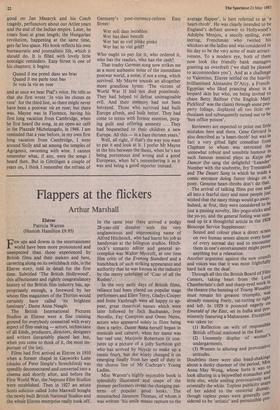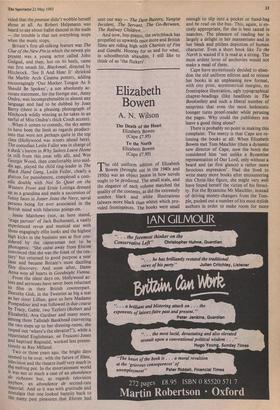Flappers at the flickers
Arthur Marshall
Elstree Patricia Warren (Hamish Hamilton £9.95) Vew ups and downs in the entertainment world have been more pronounced and unexpected than those experienced by British films and their makers and here, careering along on its switchback ride, is the Elstree story, told in detail for the first time. Subtitled 'The British Hollywood', this affectionate and rightly congratulatory history of the British film industry has, ap- propriately enough, a foreword by her whom film magazines of the Thirties would certainly have called 'its brightest luminary', Dame Anna Neagle.
The British International Pictures Studios at Elstree were a fine training ground for everybody connected with every aspect of film-making — actors, technicians of all kinds, producers, directors, designers and writers (invariably placed last but, when you come to think of it, the most im- portant of the lot).
Films had first arrived at Elstree in 1910 when a former chapel in Gasworks Lane (shades of Peter Simple's Stretchford) was speedily deconsecrated and converted into a cinema and shortly after, and before the First World War, the Neptune Film Studios were established. Then in 1927 an astute Scots solicitor called John Maxwell bought the newly built British National Studios and the whole Elstree enterprise really took off.
In the same year there arrived a podgy 28-year-old director with the very unglamorous and unpromising name of Alfred Hitchcock, who had learnt his job as handyman at the Islington studios. Hitch- cock's scenario editor and general ac- complice was Walter Mycroft, at one time film critic of the Evening Standard and a hunchback of such striking appearance and authority that he was known in the industry by the merry sobriquet of 'Czar of all the Rushes'.
In the very early days of British films, reliance had been placed on popular stage performers and Ellen Terry, Gladys Cooper and Irene Vanbrugh were all happy to ap- pear, great theatrical names which were later followed by Jack Buchanan, Ivor Novello, Fay Compton and Owen Nares, actors who appeared solely in films being then a rarity. Dame Anna herself began in musicals and cabaret, when her name was her real one, Marjorie Robertson (it con- jures up a picture of a jolly Surbiton girl who has arrived by bicycle to make up a tennis four), but she wisely changed it on emerging finally from her spell of duty in the chorus line of Mr Cochran's Young Ladies.
Miss Warren's highly enjoyable book is splendidly illustrated and snaps of the pioneer performers reveal the changing pat- terns of popular good looks. The moustached Jameson Thomas, of whom it was written 'his smile means rapture to the
average flapper', is here referred to as 'a heart-throb'. He was clearly intended to be England's defiant answer to Hollywood's Adolphe Menjou, a saucily smiling, even leering, Frenchman who twirled his whiskers at the ladies and was considered in his day to he the very acme of male attract- iveness. To a modern eye, both of them now look like friendly bank managers granting an overdraft ('we shall be pleased to accommodate you'). And as a challenge to Valentino, Elstree settled on the heavily brilliantined Alexandre D'Arcy, a French- Egyptian who liked prancing about in a leopard skin but who, on being invited to chase Betty Balfour (`the English Mary Pickford' was the claim) through some pro- perty foliage, displayed all too little en- thusiasm and subsequently turned out to be `box office poison'.
Reviewers are expected to point out little mistakes here and there. Gene Gerrard is also described as 'a heart-throb' but was in fact a very gifted light comedian from Clapham to whom was entrusted the somewhat robust and unsubtle humour in such lamous musical plays as Katja the Dancer (he sang the delightful 'Leander' Number with the soubrette, Ivy Tresmand) and The Desert Song in which he made a comic entrance doing funny things on a pony. Genuine heart-throbs don't do that. The arrival of talking films put one and all into a fearful tizzy and most people just wished that the nasty things would go away. Indeed, at first, they were considered to be just a passing novelty, like pogo-sticks and the yo-yo, and the general feeling was sum- med up in a thoughtful article in the 1928 Bioscope Service Supplement: Sound and colour place a direct strain on two human senses almost every hour of every normal day and to encounter them in one's entertainment might prove anything but a relaxation.
Another argument against the new sounds and voices was that it was most frightfully hard luck on the deaf.
Through all this the British Board of Film Censors, taking heart from the Lord Chamberlain's deft and sharp-eyed work in the theatre (the banning of Young Woodiey must remain his greatest triumph), v'Ts already roaming freely, tut-tutting to right and left. In 1929 it pounced eagerly on Emerald of the East, set in India and pro- minently featuring a Maharanee. Exception was taken to: (1) Reflection on wife of responsible British official stationed in the East. ,
undergarments. (3) display of woman s
(3) Women in alluring and provocative attitudes. Doubtless there were also head-shakings about a dusky charmer of the period, Miss Anna May Wong, whose forte it was W. look alluring in a bejewelled stomacher and, little else, while smiling provocatively and orientally the while, Topless publicity snaps of her added to the censorial dismay, though topless poses were generally Con- sidered to be 'artistic' and permissible Pro- vided that the poseuse didn't wobble herself about at all. As Robert Helpmann was heard to say about ballet danced in the nude — the trouble is that not everything stops when the music stops.
Britain's first all-talking feature was The Clue of the New Pin in which the newest pin present was a young actor called John Gielgud, and then, hot on its heels, came our first smash hit, Blackmail, directed by Hitchcock. `See It And Hear It' shrieked the Marble Arch Cinema posters, adding encouragingly `Our Mother Tongue As It Should Be Spoken', a not absolutely ac- curate statement, for the foreign star, Anny Ondra, was incomprehensible in almost any language and had to be dubbed by Joan Barry (there is a pleasing photograph of Hitchcock wildly wincing as he takes in an earful of Miss Ondra's thick Czech accent).
When it comes to comedy, the sky seems to have been the limit as regards product- ions that were not perhaps quite in the top class (Hollywood was streets ahead here). The comedian Leslie Fuller was in charge of a sheik's harem in Why Sailors Leave Home (a still from this treat tells all), and Wee Georgie Wood, then comfortably into mid- dle age, played the child ring-leader in The Black Hand Gang. Leslie Fuller, clearly a glutton for punishment, completed a com- edic double with Not So Quiet on the Western Front and Ernie Lotinga dressed up as a grandma and made a succession of funny faces in Josser Joins the Navy, naval Persons being for ever associated in the British mind with hilarious goings-on.
Jessie Matthews (not, as here stated, stage partner' of Jack Buchanan), a vastly experienced revue and musical star with those engagingly elfin looks and the highest high kicks in the business was at first con- sidered by the cameraman not to be Photogenic. `She came away from Elstree convinced that she was the freak of the cen- tury' but returned to good purpose a year later and became Britain's most dazzling film discovery. And soon after, Dame Anna won all hearts in Goodnight Vienna. From the silent days on, Hollywood ac- tors and actresses have never been reluctant to film in their British counterpart. Dorothy Gish, in the Twenties as big a star as her sister Lillian, gave us here Madame Pompadour and was followed in due course by Tracy, Gable, two Taylors (Robert and Elizabeth), Ava Gardner and many more, among them Tallulah Bankhead (surveying the two steps up to her dressing-room, she rasped out `where's the elevator?'), while a repatriated Englishman, ne Truscott-Jones and baptised Reginald, worked less preten- tiously as Ray Milland. Two or three years ago, the bright days seemed to be over, with the future of films, television and the theatre itself very much in !he melting pot. In the entertainment world it was not so much a case of an abundance de richesses but, as regards television anyhow, an abondance de second-rate material. And so it was with gratitude and nostalgia that one looked happily back to the many past pleasures that Elstree had sent our way — The Dam Busters, Yangtse Incident, The Servant, The Go-Between, The Railway Children.
And now, hey-presto, the switchback has propelled us upwards once more and British films are riding high with Chariots of Fire and Gandhi. Hooray for us and for what, in schoolboyish abandon, I still like to think of as 'the flickers'.











































 Previous page
Previous page